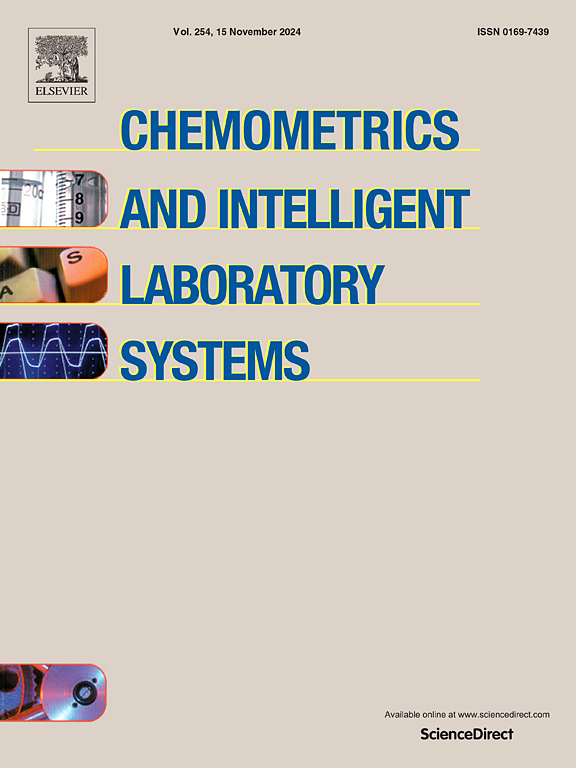A new versatile algorithm to extract particle’s features from FESEM images: method evaluation and a case study on rice kernels
IF 3.7
2区 化学
Q2 AUTOMATION & CONTROL SYSTEMS
Chemometrics and Intelligent Laboratory Systems
Pub Date : 2025-04-24
DOI:10.1016/j.chemolab.2025.105415
引用次数: 0
Abstract
Image analysis approaches allow to quickly extract important information from images of diverse nature. Many techniques produce as a result images that contain regular and irregular objects. The ability of automatically extracting the objects and their related morphological features and properties is becoming fundamental, especially when the number of images to analyse is consistent.
In this context, a new algorithm able to extract a series of morphological features from FESEM images was developed. Starting from a case study on 54 varieties of rice kernels, 220 images were acquired, and the algorithm was coded with the aim of extracting information from the round-shaped starch particles naturally present in rice kernels. The algorithm constitutes of different steps to segment the images and identify the object shapes and boundaries. Once those objects are identified, the algorithm extracts their morphological features, the number of identified objects and the amount of empty spaces among those objects.
The developed algorithm is suitable for a rapid and automated analysis of several images, with the aim of extracting object-related morphological features and information about the general objects space disposition. The use of adaptive thresholds and correction steps allow to analyse images of different natures containing also defective and non-representative objects that will be automatically removed from the features calculation. In addition, to evaluate the algorithm performances, a Design of Experiment approach was developed to determine the effect of the input parameters choice on the algorithm output results, highlighting which parameters show a stronger effect on the output.

从FESEM图像中提取粒子特征的一种新的通用算法:方法评价及以米粒为例研究
图像分析方法允许从不同性质的图像中快速提取重要信息。许多技术产生的结果是图像包含规则和不规则的对象。自动提取物体及其相关形态特征和属性的能力变得越来越重要,特别是当需要分析的图像数量一致时。在此背景下,提出了一种能够从FESEM图像中提取一系列形态学特征的新算法。以54个品种的米粒为例,获取了220张图像,并对算法进行编码,目的是从米粒中天然存在的圆形淀粉颗粒中提取信息。该算法由多个步骤组成,分别对图像进行分割,识别目标形状和边界。一旦这些物体被识别,算法提取它们的形态特征,识别物体的数量和这些物体之间的空白量。该算法适用于多幅图像的快速自动分析,目的是提取与目标相关的形态学特征和目标空间分布的一般信息。使用自适应阈值和校正步骤可以分析不同性质的图像,这些图像也包含有缺陷的和非代表性的物体,这些物体将自动从特征计算中删除。此外,为了评估算法的性能,我们开发了一种实验设计方法来确定输入参数的选择对算法输出结果的影响,突出显示哪些参数对输出的影响更强。
本文章由计算机程序翻译,如有差异,请以英文原文为准。
求助全文
约1分钟内获得全文
求助全文
来源期刊
CiteScore
7.50
自引率
7.70%
发文量
169
审稿时长
3.4 months
期刊介绍:
Chemometrics and Intelligent Laboratory Systems publishes original research papers, short communications, reviews, tutorials and Original Software Publications reporting on development of novel statistical, mathematical, or computer techniques in Chemistry and related disciplines.
Chemometrics is the chemical discipline that uses mathematical and statistical methods to design or select optimal procedures and experiments, and to provide maximum chemical information by analysing chemical data.
The journal deals with the following topics:
1) Development of new statistical, mathematical and chemometrical methods for Chemistry and related fields (Environmental Chemistry, Biochemistry, Toxicology, System Biology, -Omics, etc.)
2) Novel applications of chemometrics to all branches of Chemistry and related fields (typical domains of interest are: process data analysis, experimental design, data mining, signal processing, supervised modelling, decision making, robust statistics, mixture analysis, multivariate calibration etc.) Routine applications of established chemometrical techniques will not be considered.
3) Development of new software that provides novel tools or truly advances the use of chemometrical methods.
4) Well characterized data sets to test performance for the new methods and software.
The journal complies with International Committee of Medical Journal Editors'' Uniform requirements for manuscripts.

 求助内容:
求助内容: 应助结果提醒方式:
应助结果提醒方式:


